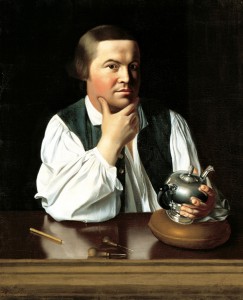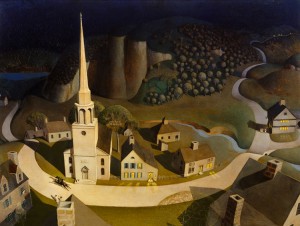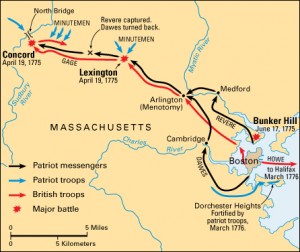Paul Revere 200
May 10, 2018
On May 10, 1818, 200 years ago today, American craftsman and patriot Paul Revere died at age 83 in his home in Boston, Massachusetts. Revere became famous for his contributions during the American Revolution (1775-1783). In April 1775, he rode on horseback from Boston to nearby Lexington, carrying news of the approach of British troops. Revere warned the patriot leaders Samuel Adams and John Hancock of their danger and called the citizens of the countryside to arms. His exploit inspired Henry Wadsworth Longfellow’s “Paul Revere’s Ride” (1861), one of the most popular poems in American literature. Revere made other contributions during the American Revolution and also aided the industrial growth of the United States.

The American artist John Singleton Copley painted this portrait of Paul Revere in 1768, seven years before his famous ride. Credit: Oil painting on canvas (1768) by John Singleton Copley; © GL Archive/Alamy Images
Paul Revere was born in Boston, most likely in December 1734. He was educated in Boston and learned the silversmith’s trade. In 1756, he served briefly in the French and Indian War before taking over his father’s silversmith business.

Grant Wood’s The Midnight Ride of Paul Revere portrays the American patriot’s famous ride during the Revolutionary War. Credit: The Midnight Ride of Paul Revere (1931) Oil on masonite by Grant Wood, The Metropolitan Museum of Art (Art Resource)
Revere supported American independence from the United Kingdom. He engraved a number of political cartoons that received wide attention. Revere took part in the Boston Tea Party on Dec. 16, 1773, and he also served as a special messenger for the Boston patriots. Two days before his famous ride took place in 1775, he galloped to Concord to warn patriots there to move their military supplies.

Click to view larger image
Clashes at Lexington and Concord opened the American Revolution in April 1775. This map traces the routes traveled by Paul Revere and William Dawes to warn colonists of the British approach. Credit: WORLD BOOK map
In 1775, King George III instructed General Thomas Gage, the British commander in chief in Massachusetts, to enforce order among the rebellious colonists. Gage ordered Lieutenant Colonel Francis Smith to Concord with a detachment of 700 men. Smith and his soldiers were to destroy the supplies there and arrest Samuel Adams and John Hancock for treason. Revere and fellow patriot William Dawes were sent by separate routes to warn Adams and Hancock in Lexington and the patriots in Concord. Revere arranged for a signal to be flashed from the steeple of Boston’s Old North Church. Two lanterns would mean the British were coming by water, and one, by land. Contrary to Longfellow’s account, the signal was not sent to Revere. Instead, Revere directed that the signal be sent to other patriots.
Revere left Boston at about 10 p.m. and arrived in Lexington about midnight, riding a borrowed horse. Shortly after 1 a.m., Revere, Dawes, and another messenger, Samuel Prescott, left for Concord. A British patrol surprised them on their way. Prescott and Dawes escaped, but Revere was captured. Only Prescott got through to Concord. The British released Revere and let him return to Lexington without his horse.
Revere served in the Continental Army during the war and oversaw the construction of a gunpowder mill near Boston. He also engraved and printed paper currency for Massachusetts, and he made the state seal still used by Massachusetts. Before, during, and after the war, Revere was well known as a silversmith and he also built the first successful copper-rolling mill in the United States.


